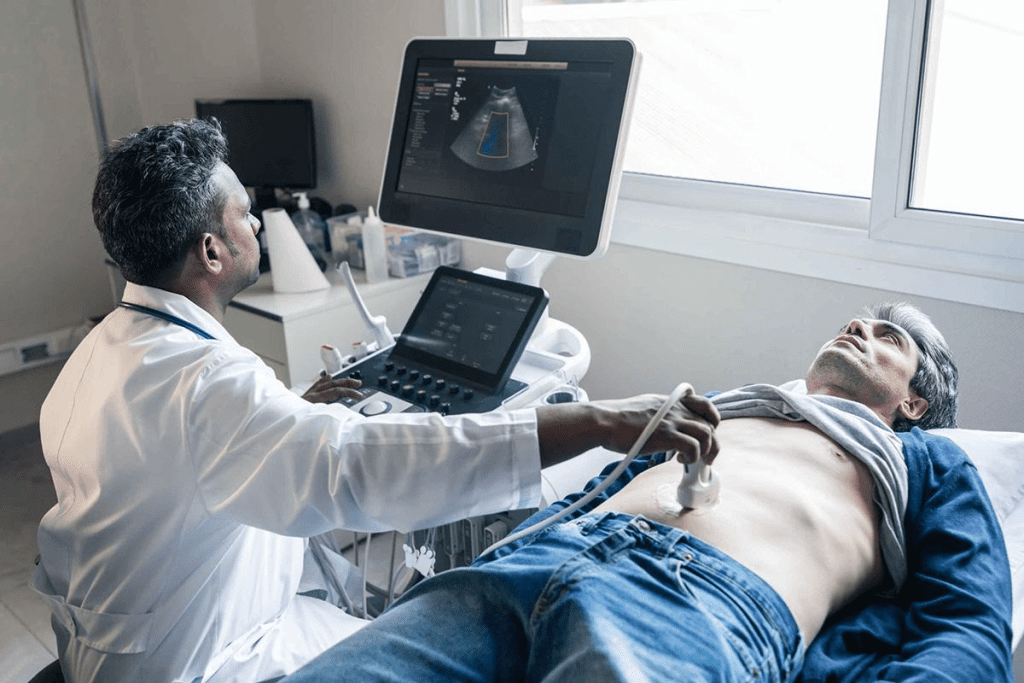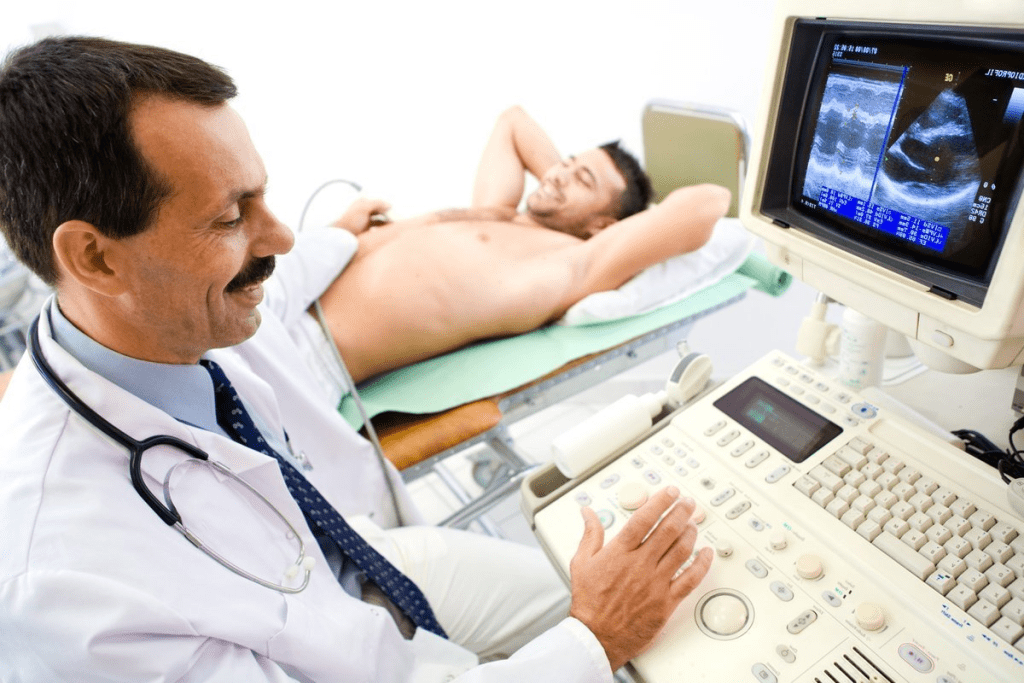Last Updated on November 25, 2025 by
Medical professionals, including a urologist, often use ultrasound technology to find and track urological issues. It’s safe, doesn’t hurt, and is easy on the wallet. It works by sending sound waves into the body to make images, mainly of the kidneys and bladder. When doctors check the urinary tract with ultrasound, it’s called a kidney or renal ultrasound. This tool is great for spotting big problems in patients with blood in their urine. It also helps avoid more tests for issues in the lower urinary tract.

At Liv Hospital, we love using ultrasound technology for quick and precise diagnoses. It shows our commitment to top-notch care with the latest methods. Ultrasound helps us give full care to those with urinary problems.
Ultrasound is key in urology because it’s safe, works well, and is affordable. We use it to give patients a non-invasive and accurate test. This method makes patients more comfortable and helps us make better diagnoses.
Ultrasound is a top choice in urology because it’s safe and doesn’t use harmful radiation. It’s great for patients who need many tests or are worried about radiation. A study shows,
‘the safety profile of ultrasound is well-established, making it an ideal diagnostic tool for a wide range of urological conditions.’
We see the importance of ultrasound in keeping our patients safe during tests.

Ultrasound is also cost-effective, which is a big plus. It’s cheaper than CT scans or MRI, making it easier to access. This is important in today’s healthcare, where we need to save money without sacrificing quality.
Using ultrasound can also save money in the long run. It helps avoid more expensive tests and treatments. This makes it a vital tool for us, helping us offer great care while watching our budget.
Urologists use ultrasound to check different parts of the body. They look at the urinary tract, like the kidneys, bladder, and prostate. This method is safe and helps them find any problems.
They check the kidneys, bladder, and prostate for any issues. The kidneys are looked at for size, shape, and position. They also check for cysts, tumors, or stones.
The bladder is checked for its size, wall thickness, and any masses or stones. In men, the prostate is examined for size and any signs of problems like BPH or prostate cancer.
Ultrasound is great for finding many urological issues. It can spot kidney stones, cysts, and tumors in the kidneys or bladder. In the prostate, it can find signs of BPH or cancer.
It also finds issues like hydronephrosis, where the kidney swells because of urine blockage. By finding these problems, urologists can plan the right treatment. Ultrasound’s real-time images help them see how organs change and adjust treatments as needed.
Ultrasound technology is key in diagnosing flank pain and kidney issues. Flank pain often leads urologists to use ultrasound to find the cause.

45% of urological ultrasounds are for flank pain. This shows how important ultrasound is in finding kidney problems. It highlights that many urology exams use ultrasound to check for flank pain.
Ultrasound is chosen because it’s safe, non-invasive, and gives good diagnostic info.
Ultrasound is great at finding kidney stones and hydronephrosis. Kidney stones cause a lot of pain and can lead to serious issues if not treated. Hydronephrosis means a kidney is swollen from urine buildup and needs quick medical help.
Ultrasound also checks for renal cysts and masses. Renal cysts are fluid-filled sacs on the kidneys, mostly harmless but sometimes need checking. Ultrasound helps figure out if these cysts or masses are dangerous.
Ultrasound helps urologists find and treat many kidney problems. This improves patients’ health and life quality.
When patients have lower urinary tract symptoms, we use ultrasound to help. This tool is key in figuring out what’s causing these symptoms. It helps us find the root cause.
Ultrasound is great for checking benign prostatic hyperplasia (BPH). BPH is when the prostate gets bigger, causing urinary issues. It lets us see how big the prostate is and how it affects the urethra.
A study on PMC shows ultrasound is good for checking prostate size. It helps us decide the best treatment.
Ultrasound is also key for checking bladder function. It looks at the bladder’s size, thickness, and for any problems like tumors. This helps us find out why patients have LUTS.
Measuring post-void residual (PVR) urine is also important. PVR is the urine left in the bladder after you pee. Ultrasound lets us measure PVR accurately. This is vital for diagnosing issues like urinary retention.
By using ultrasound, we can give a detailed check-up for LUTS. It’s a non-invasive way to help patients. This makes it a top choice for diagnosing urinary problems.
When blood shows up in the urine, finding the cause is key. Hematuria, or blood in urine, can point to many urological issues. We rely on ultrasound to check for these problems.
Ultrasound helps find significant findings in over 60% of hematuria cases. This shows how vital ultrasound is in finding the cause of blood in urine. These findings can be anything from kidney stones to tumors.
Ultrasound findings are key for both diagnosis and managing around 81% of hematuria cases. Knowing the cause helps doctors create a treatment plan that fits the patient’s needs.
After finding important signs, it’s important to keep an eye on the condition. This might mean regular ultrasounds, more tests, or other steps to manage the issue.
We stress the need for these follow-ups for complete care. They help improve patient results and support them through treatment.
Urologists use ultrasound to diagnose urolithiasis because it’s accurate and doesn’t hurt. Urolithiasis means stones in the urinary tract, causing pain. We use ultrasound to find these stones and watch how they change.
Ultrasound is very good at finding kidney stones. It’s better than other methods. Knowing how accurate ultrasound is helps us find stones and plan treatment.
We watch stones with ultrasound to see if treatment is working. This is key for changing treatment plans. By seeing how stones change, we know if we need to try something else.
Ultrasound is safe and doesn’t use radiation. It’s perfect for watching stones over time. This makes it great for managing urolithiasis long-term.
Ultrasound beats other methods like CT scans because it’s safe and doesn’t use radiation. It’s better for patients who need many scans. Plus, it’s cheaper and easier to find.
Using ultrasound helps us give our patients the best care for urolithiasis. From the start to managing it long-term, we aim for the best results.
Office-based ultrasound has changed how urologists work. It has made diagnosing and treating patients better. This technology brings many benefits to urology.
One big plus of office-based ultrasound is it cuts down on extra tests. It can skip further imaging in up to 82.9% of cases. This means urologists can give accurate diagnoses right in the office.
This saves time and money. It makes the whole process smoother and cheaper for everyone.
Office-based ultrasound also lets urologists get results fast. This is key for treating things like urinary tract infections or kidney stones quickly. Quick action can really help patients.
Being able to diagnose and plan treatment in one visit makes patients happier. It also makes care better overall.
The use of office-based ultrasound in urology has grown a lot. Now, urologists use it much more often. This shows how important it has become in urology.
As we keep using and improving ultrasound, patient care will get even better. The benefits are clear, and its role in urology will only grow.
Ultrasound technology is key in urological care. It’s safe, non-invasive, and works well. It has changed how we diagnose and treat urological issues.
Ultrasound is vital for better urological care. Its safety and effectiveness are unmatched. As technology grows, ultrasound will keep leading the way in urology.
Using ultrasound technology can make patient care better. It helps improve health outcomes and care quality in urology. This technology will keep shaping urological care, helping both healthcare providers and patients.
A urologist is a doctor who deals with the urinary tract and male reproductive system. They use tools like ultrasound to check patients and plan treatments.
Urologists use ultrasounds for patients with blood in their urine. It’s a good tool for finding problems in over 60% of cases. It helps spot issues like stones, tumors, or infections, so they can be treated quickly.
Urolithiasis means having stones in the urinary tract. Ultrasound is great for finding these stones and tracking them. It’s safe and doesn’t use radiation, making it perfect for diagnosing and managing stones.
Ultrasound helps check LUTS by looking at bladder function and prostate health. It helps find the cause of LUTS. This way, urologists can plan better treatments.
Office-based ultrasound has many benefits. It reduces the need for more tests, gives quick results, and helps plan treatments. It lets urologists make quick decisions and give better care.
Ultrasound is cheaper, safer, and doesn’t use radiation. While CT scans and MRI give detailed images, ultrasound is often the first choice. It’s safe and effective for initial checks and follow-ups.
During an ultrasound, a urologist looks at the kidneys, bladder, and prostate. They check for problems like cysts, tumors, stones, and infections. Ultrasound’s real-time images help them see the organs’ size, shape, and texture.
Ultrasound is key in finding the cause of flank pain and kidney issues. It’s great for spotting problems like stones, swelling, and cysts or tumors. It’s used in 45% of urological ultrasounds for this reason.
Ultrasound is vital in managing urological conditions. It’s safe, non-invasive, and effective for diagnosis and monitoring. It helps urologists find problems, track changes, and adjust treatments. This improves patient care and outcomes.
Subscribe to our e-newsletter to stay informed about the latest innovations in the world of health and exclusive offers!